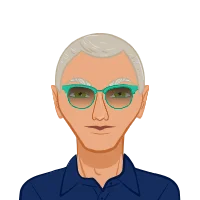The Versatile World of Fractal Geometry: Exploring Applications and Insights

In the fascinating realm of mathematics, fractal geometry emerges as a captivating and versatile field with the power to transcend theoretical boundaries and ignite practical innovations. In this comprehensive exploration, we delve into the myriad applications of fractal geometry in computer graphics, image compression, finance, biological systems, art, and architecture. Whether you're a university student seeking to complete your fractal geometry assignment or an enthusiast eager to uncover the multifaceted world of fractals, join us as we unravel the beauty and significance of these intricate mathematical structures.
Understanding Fractal Geometry
Fractals are complex, self-similar structures that exhibit intricate patterns regardless of the level of magnification. In essence, they challenge traditional geometric shapes like circles, squares, and triangles, which maintain simplicity under zooming in or out. The key elements of fractals include self-similarity, scale invariance, and fractional dimensionality.

Self-similarity refers to the property where parts of the fractal resemble the whole, even at varying scales. Scale invariance means that fractals maintain their structural characteristics regardless of the level of magnification. And fractional dimensionality arises from the fact that fractals can have non-integer dimensions, unlike classical Euclidean geometry.
Now, let's explore how fractal geometry finds applications in various domains:
- Computer Graphics:
- Image Compression:
- Medical Imaging: In the field of medical imaging, where high-resolution images are crucial for diagnosis and treatment, fractal compression can help transmit these images efficiently, reducing the burden on network resources.
- Remote Sensing: In remote sensing applications, such as satellite imagery, where large datasets need to be transmitted from space to Earth, fractal compression can minimize the amount of data sent while maintaining image quality.
- Digital Photography: In everyday life, digital cameras and smartphones use various image compression techniques. Understanding fractal compression can help photographers and graphic designers make informed choices about image quality and file size when capturing and sharing photos.
- Finance:
- Biological Systems:
- Medical Research: Fractal analysis of blood vessel networks can help medical researchers understand diseases like cancer, where abnormal vascular growth is a hallmark feature. This understanding can lead to the development of more targeted treatments.
- Ecology: In ecology, fractal geometry is used to analyze patterns of plant distribution, animal movement, and river networks. These analyses aid in studying the spatial organization of ecosystems and the flow of energy and resources.
- Neuroscience: The complex branching patterns of neurons in the brain also exhibit fractal-like characteristics. Studying these patterns can provide insights into brain connectivity, information processing, and neurological disorders.
Fractal geometry has not only transformed the field of computer graphics but has also become an integral part of creating visually stunning and realistic virtual worlds. Traditional methods of rendering natural scenes like landscapes, clouds, and forests required enormous amounts of data and computation. However, fractals offer an elegant solution to this problem.
One of the most famous and visually captivating fractals is the Mandelbrot Set. It's generated by iterating a simple mathematical equation over a complex plane of numbers, and the results are incredibly intricate and self-replicating shapes. These fractals serve as the foundation for creating breathtaking landscapes in video games, movies, and simulations. By zooming in on any part of the Mandelbrot Set, you reveal a new world with similar characteristics to the whole set—a perfect example of self-similarity in fractal geometry.
What's particularly fascinating is that these fractal-based landscapes can be generated with a minimal amount of data and computation, making it possible to create vast and detailed virtual environments without overloading computer resources. This efficiency is a game-changer for industries reliant on computer graphics, as it allows for more realistic and immersive experiences while minimizing hardware and energy requirements.
Furthermore, fractals are not limited to just landscapes. They can also be applied to generating realistic textures, patterns, and even characters in the virtual world. For example, in gaming, fractal-based algorithms can be used to create realistic-looking foliage, such as leaves and grass, which sway and move realistically in response to environmental conditions like wind. This level of detail and realism adds to the overall immersion of the gaming experience.
Practical Implication: Computer graphics professionals can leverage fractal geometry to create visually appealing virtual worlds efficiently, solve complex problems in 3D modeling and animation, and offer users an unparalleled gaming and cinematic experience. So, for university students looking to solve their math assignments or aspiring graphic designers, understanding the applications of fractal geometry in computer graphics is a valuable skill.
Fractal-based image compression is another area where the applications of fractal geometry shine. Image compression techniques aim to reduce the size of image files while preserving image quality. Traditional compression methods, like JPEG, rely on removing image data, which often leads to a loss of quality. In contrast, fractal compression works by identifying and encoding self-similarities within an image efficiently.
The concept of self-similarity in fractal geometry plays a crucial role in this process. By finding repeating patterns and structures within an image, fractal compression algorithms can represent the entire image using a set of mathematical transformations. These transformations are applied iteratively to create a compressed representation of the original image, which can then be decoded to reconstruct the image with minimal loss in quality.
The practical implication of fractal-based image compression is significant. It enables the transmission of high-quality images over networks with limited bandwidth and storage capacity. This application is particularly relevant in various fields:
By grasping the principles of fractal-based image compression, university students can appreciate how mathematics plays a vital role in optimizing data transmission, storage, and visual quality. It's not just about solving math assignments; it's about understanding how mathematics can be applied in practical, real-world scenarios to improve efficiency and usability.
Fractal geometry's applications extend to the intriguing world of financial markets. Financial time series data, which includes stock prices, currency exchange rates, and commodity prices, often exhibit complex and irregular patterns that classical statistical models struggle to capture. Fractal analysis offers a more nuanced and accurate perspective on market dynamics.
One of the key tools in fractal analysis of financial time series data is the Hurst exponent. The Hurst exponent is a parameter derived from fractal analysis that measures the long-term persistence of a time series. In the context of financial markets, it can help identify trends, predict market behavior, and assess risk more effectively than traditional statistical methods.
The financial market is inherently chaotic and influenced by numerous factors, including economic data, geopolitical events, and investor sentiment. These factors contribute to the complex and often fractal-like nature of market movements. While traditional statistical models may assume that market returns are normally distributed, fractal analysis recognizes that they often exhibit fat-tailed distributions and long-range dependence.
Practical Implication: By applying fractal analysis to financial data, investors, traders, and financial analysts can gain deeper insights into market behavior, enhance risk management strategies, and make more informed decisions. For university students studying finance or economics, understanding fractal geometry's role in financial markets is not only academically enriching but also potentially lucrative when applied to real-world investment strategies.
Moreover, fractal analysis isn't limited to stock markets; it can be applied to other financial time series data, such as currency exchange rates, commodity prices, and even cryptocurrencies like Bitcoin. As these markets continue to evolve and become more interconnected, the need for sophisticated analytical tools like fractal geometry becomes increasingly apparent.
Fractal geometry provides valuable insights into the complexity of biological structures and processes. In nature, many systems, ranging from blood vessels and lung networks to tree branches and river networks, exhibit fractal-like patterns. Understanding these fractal characteristics is crucial for unraveling the mysteries of life at various scales.
One of the most striking examples of fractal geometry in biology is the branching pattern of blood vessels. Our circulatory system is a complex network of arteries, veins, and capillaries that transport nutrients and oxygen to cells and remove waste products. This network's fractal-like branching ensures efficient nutrient transport and oxygen exchange throughout the body.
Practical Implication: The application of fractal geometry in biology extends to various areas:
Fractal geometry helps biologists, medical researchers, ecologists, and neuroscientists model and understand the intricate structures and processes within biological systems. This knowledge can lead to breakthroughs in healthcare, environmental science, and our understanding of the natural world.
Fractal Geometry in Art and Architecture: Inspiring Creativity and Design
Beyond its applications in computer graphics, image compression, finance, and biological systems, fractal geometry has also made a profound impact in the realms of art and architecture. This section will delve into how fractals have inspired creativity and influenced architectural design, showcasing the practical implications in these fields.
Art:
Fractals have captivated the art world with their infinite complexity and aesthetic appeal. Artists across various mediums have drawn inspiration from fractal geometry to create visually stunning and thought-provoking works of art. Fractal art, also known as "algorithmic art" or "digital art," explores the intricate patterns and self-similar structures inherent in fractals.
One notable example is the use of fractal patterns in abstract art. Artists like Jackson Pollock and Piet Mondrian, known for their abstract expressionism and geometric abstraction, respectively, unknowingly incorporated fractal-like qualities in their paintings. Today, digital artists actively harness fractal algorithms to generate artwork that is not only visually striking but also deeply rooted in mathematical principles.
Practical Implication: Understanding the principles of fractal geometry can broaden the horizons of artists and designers, providing them with new tools and perspectives to create innovative and captivating artwork. Whether it's in digital art, sculpture, or even music composition, fractals offer endless possibilities for artistic expression.
Architecture:
Fractal geometry has also left its mark on architectural design. Architects have embraced fractal principles to create buildings and structures that blend seamlessly with their natural surroundings while optimizing functionality and sustainability.
One remarkable example is the Eden Project in Cornwall, UK. This iconic structure comprises a series of interconnected geodesic domes housing diverse biomes, each replicating a different climate and ecosystem. The design of the geodesic domes draws inspiration from the self-similar, efficient structures found in nature, such as soap bubbles and diatoms. This not only creates a visually stunning architectural masterpiece but also ensures optimal energy efficiency and environmental sustainability.
Another notable application of fractal geometry in architecture is in the design of façades and building materials. Fractal patterns can be employed to create façades that minimize solar heat gain while maximizing natural light penetration. This approach enhances energy efficiency, reduces the building's carbon footprint, and creates aesthetically pleasing designs that harmonize with the environment.
Practical Implication: Architects and urban planners can leverage fractal principles to design sustainable, visually appealing, and environmentally friendly structures. Understanding how fractal geometry influences architectural design is crucial for creating buildings that are both functional and harmonious with the natural world.
Conclusion
Fractal geometry, with its foundation in self-similarity, scale invariance, and fractional dimensionality, has far-reaching applications in diverse fields. From revolutionizing computer graphics and image compression to enhancing our understanding of financial markets and biological systems, fractals continue to play a crucial role in solving complex problems and advancing various disciplines. By understanding the theoretical underpinnings of fractal geometry and its practical implications, university students and researchers can harness its power to solve math assignments and make meaningful contributions to their respective fields. So, embrace the beauty of fractals and discover how they can help you solve your math assignment and unlock new avenues of knowledge.